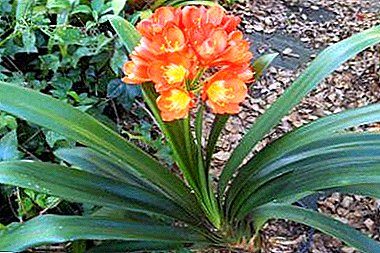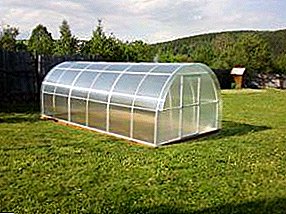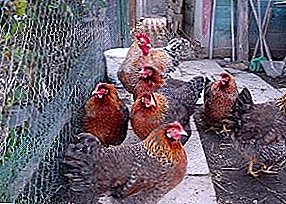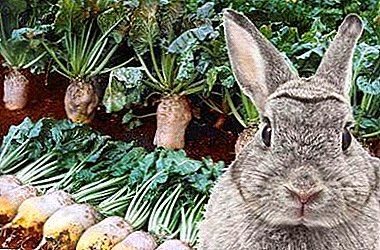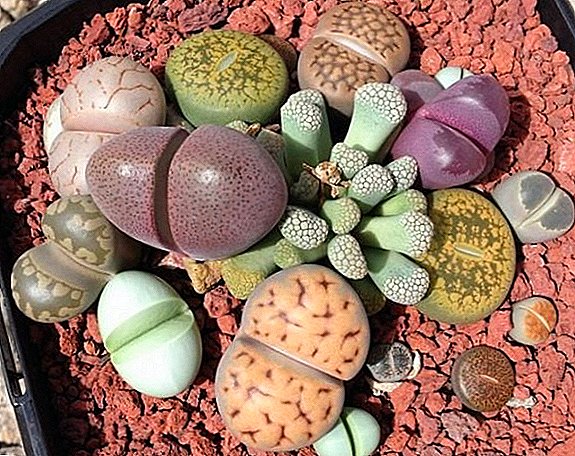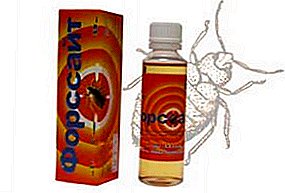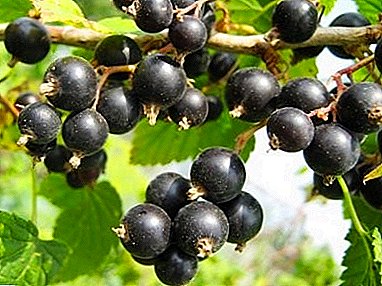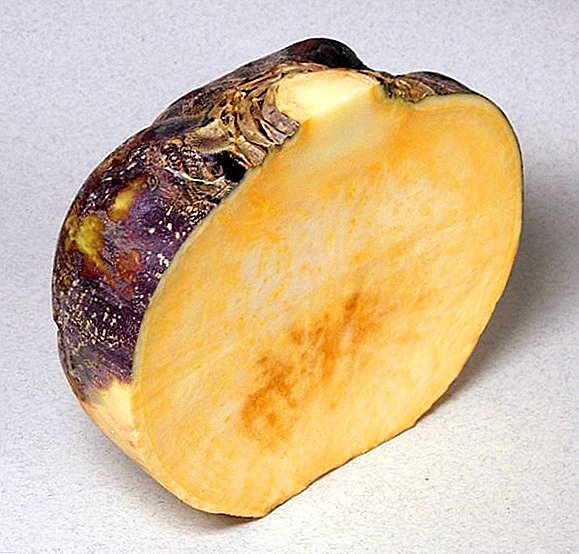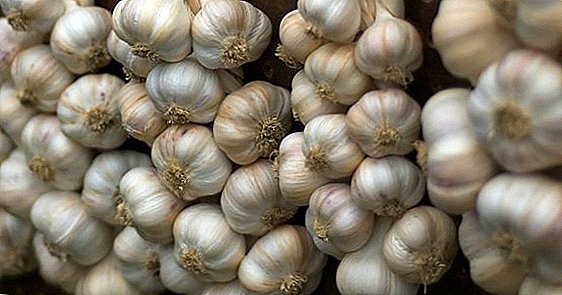 Growing garlic, almost every gardener faced with the problem of yellowing of garlic leaves. This may seem normal, as the leaves usually turn yellow in summer, which indicates harvest time. But why the leaves turn yellow in garlic in the spring? By digging up yellowed garlic, you can detect black spots, deformed bulbs, stunted roots, and other abnormalities. It may be that the garlic looks beautiful after harvesting, but after a month it becomes soft and shows signs of decay. Below is an overview. fungi, pests, and other stressors that can adversely affect garlic yield.
Growing garlic, almost every gardener faced with the problem of yellowing of garlic leaves. This may seem normal, as the leaves usually turn yellow in summer, which indicates harvest time. But why the leaves turn yellow in garlic in the spring? By digging up yellowed garlic, you can detect black spots, deformed bulbs, stunted roots, and other abnormalities. It may be that the garlic looks beautiful after harvesting, but after a month it becomes soft and shows signs of decay. Below is an overview. fungi, pests, and other stressors that can adversely affect garlic yield.
Spring frosts are a threat to garlic
Distinguish spring (spring) and winter (winter) garlic. The gardeners noticed that winter garlic mostly turns yellow. Yellowing of winter garlic often occurs in early spring - during the period of spring frosts. A thick layer of snow no longer covers the plant, and it becomes vulnerable. In such conditions, the roots weaken, and garlic takes energy from its leaves.
Too deep planting causes freezing of garlic and the appearance of yellow leaves. Therefore, landing is most preferable at a depth of 5-7 cm. You can also prevent yellowing by covering young sprouts of garlic with a plastic wrap.
 If you notice that garlic is already exposed to the first spring frosts, treat the plant with special stimulants as soon as possible. For this, such biostimulants as "Epin" and "Zircon" are excellent. These drugs improve flowering, rooting, plant resistance to disease.
If you notice that garlic is already exposed to the first spring frosts, treat the plant with special stimulants as soon as possible. For this, such biostimulants as "Epin" and "Zircon" are excellent. These drugs improve flowering, rooting, plant resistance to disease.
Too acidic soil causes yellowing of leaves.
Another reason why winter garlic turns yellow is in acidic soil. Garlic is a plant that produces a good harvest only on neutral soil. And with a high acidity of the soil the appearance of the plant deteriorates. Sour garlic soil is absolutely not suitable. The soil should be sufficiently moist and oxygen-rich.
Soil acidity can be reduced; this should be done during the fall. It is necessary to prepare limestone. Lime is introduced in the following proportions: for strongly acidic soil (PH 4 and less) - 50-70 kg of lime, for medium acid (PH 4-5) - 35- 45 kg, and for slightly acidic soil (PH 5-6), 30- 35 kg. Limestone must be mixed well with the soil, and only then can beds be formed for planting garlic. But ideally, to prevent yellowing of the plant in the future, it is necessary to use large cloves of garlic for planting. In addition, watering beds is recommended only after mulching.
Nitrogen deficiency and garlic
The limited amount of nitrogen in the soil is often the answer to the question of why the leaves of garlic turn yellow in spring. Planted before the onset of winter, plants often experience nitrogen starvation. To avoid this, in the autumn you need to use ammonium sulfate.
 The process of loss of nitrogen from the soil, as a rule, occurs in the season of frequent rains. Rain washed away fertilizer from the soil. To prevent nitrogen starvation of garlic, it is necessary to fertilize the soil in early spring when the plants are in the active growth phase. It is better to fertilize the land for garlic with organic or mineral substances. Urea (carbamide) or liquid manure are excellent as nitrogen fertilizers.
The process of loss of nitrogen from the soil, as a rule, occurs in the season of frequent rains. Rain washed away fertilizer from the soil. To prevent nitrogen starvation of garlic, it is necessary to fertilize the soil in early spring when the plants are in the active growth phase. It is better to fertilize the land for garlic with organic or mineral substances. Urea (carbamide) or liquid manure are excellent as nitrogen fertilizers.
Usually, between the rows of garlic make shallow grooves and lay there fertilizer (according to instructions). The grooves need to be leveled, then pour the area with water. To keep the soil moist, it is better to top in addition compost or dry humus.
Did you know? Experienced gardeners advise another technology of the process of applying nitrogen fertilizers to the soil. First, a solution is prepared: 20 g of fertilizer per bucket of water. Then the solution is watered with this solution. Thus, the essence of the method is that water and fertilizers are pre-mixed. This method is more effective, since the necessary substances immediately go to garlic.
Why yellow leaves of garlic, insufficient watering plants
If the leaves of garlic turn yellow, and you do not know why, then the reason may be in insufficient watering of the plant. The lack of moisture often leads to a change in the color of the leaves of young garlic.
 Do not forget to carefully and regularly water the garlic. This is especially important in May-June, when plant formation occurs. In the spring, after melting snow, it is necessary to monitor the condition of the soil. To do this, loosen the soil under garlic, after which it becomes clear whether the soil is enough water. If moisture is not enough, you should start regular watering of garlic.
Do not forget to carefully and regularly water the garlic. This is especially important in May-June, when plant formation occurs. In the spring, after melting snow, it is necessary to monitor the condition of the soil. To do this, loosen the soil under garlic, after which it becomes clear whether the soil is enough water. If moisture is not enough, you should start regular watering of garlic.
If you noticed excessive soil moisture, then you need to make drainage channels along all rows of garlic.
Important! When watering garlic, it is important to use the water that has settled and warmed up for some time in the sun. With not very dry weather, with precipitation, about 10 liters of water will be spent per 1 square meter. Just do not forget between watering to make a mandatory break, about 9 days.
How does potassium deficiency affect garlic?
Garlic is always sensitive to potassium deficiency: young leaves of garlic turn yellow, wither and dry; roots are damaged; inhibited plant growth. Therefore, it is necessary to periodically fertilize the soil with potassium sulfate in an amount of 20 gn and 10 l of water. Potassium stimulates the growth of garlic, improves water balance, increases plant resistance to drought and pests, improves its frost resistance.
 Potassium deficiency can be diagnosed not only by the yellowed leaves, but also by the appearance of a narrow burnt edge along the very edge of the leaf - “edge burn”. Uneven growth of leaves is possible, they become thin and drooping.
Potassium deficiency can be diagnosed not only by the yellowed leaves, but also by the appearance of a narrow burnt edge along the very edge of the leaf - “edge burn”. Uneven growth of leaves is possible, they become thin and drooping.
Wood ash is useful as a natural fertilizer. Ash is a good potash and phosphate fertilizer. Sprinkle ash in small quantities (at the rate of 100 g / m). The soil is enriched with mineral trace elements necessary for the plant.
Important! Garlic does not tolerate the presence of chlorine. Therefore, it is potassium sulphate, not potassium chloride, that is used as a source of potassium for foliar feeding.
Diseases of garlic and yellowing leaves
Sometimes it is difficult to understand what exactly happens to the plant. Only a careful analysis will help to determine the exact reason why the leaves of garlic turn yellow, and what to do in such a situation. Try to initially monitor the condition of the soil and the purity of the planting material. Diseases of winter garlic appear as turbid light green spots on the leaves, then the leaves turn yellow. Leaf spot affects the head of garlic, staying there until spring.
The most common diseases of garlic are:
White rot of garlic. The leaves of affected plants turn yellow and fade, the bulbs rot and become covered with white mold. The disease proceeds more intensively in the dry spring and when there is insufficient nutrition with nitrogen. If garlic has become infected with white rot, it will be hard enough to get rid of this fungus. White rot can live in the soil for more than 30 years and is particularly active in cold, wet conditions. White rot is visible on the base of the leaves, near the soil.
 Leaves starting from the tips turn yellow prematurely. Stems, bulbs, and then the roots begin to rot. Plants one after another die. On the entire surface of the rotted garlic can see fluffy white formations. To protect the garlic from white rot, use mineral fertilizers (for example, ammonium nitrate). Do not forget about regular watering, especially during droughts (in spring).
Leaves starting from the tips turn yellow prematurely. Stems, bulbs, and then the roots begin to rot. Plants one after another die. On the entire surface of the rotted garlic can see fluffy white formations. To protect the garlic from white rot, use mineral fertilizers (for example, ammonium nitrate). Do not forget about regular watering, especially during droughts (in spring).
Basal rot. This fungus is present in almost all soils, but, as a rule, is not a big problem if the plants are not weakened by other stresses. Yellowing begins with the tips of the leaves and moves down. The disease looks very similar to white rot, but garlic decomposes at a slower rate.
The treachery of basal rot is that it is invisible above the ground until the garlic leaves turn yellow. During storage, basal rot continues to destroy the garlic harvest. Having noticed prematurely yellowed leaves, immediately remove diseased plants to prevent the spread of the disease. Disinfection of planting material with antifungal drug "Thiram" will help in the fight against basal rot.
Black mold of garlic or asperillosis. Black mold is considered a very dangerous disease. The main reason for its appearance is the wrong temperature environment. Especially often the infection affects unripe garlic. Plants get an unhealthy appearance, the bulbs become soft, and the leaves - yellow.
 Fusarium Another common disease of garlic, in which the leaves turn yellow actively, is fusarium. The cause of this disease lies in high humidity or in excess of moisture. Already in the process of ripening the leaves turn yellow, starting from the very top. The disease also manifests itself as brown stripes on the stems. In this case, it is necessary to treat the garlic with potassium permanganate solution.
Fusarium Another common disease of garlic, in which the leaves turn yellow actively, is fusarium. The cause of this disease lies in high humidity or in excess of moisture. Already in the process of ripening the leaves turn yellow, starting from the very top. The disease also manifests itself as brown stripes on the stems. In this case, it is necessary to treat the garlic with potassium permanganate solution.
Green (blue) mold or penicillus. The mold looks like a blue-green rot on the cloves of garlic. Infection occurs through the air and affects predominantly early garlic. Plants gradually turn yellow and die. But most often the green mold affects the garlic after harvest, as a result of careless handling. It is necessary to control the garlic during storage and remove damaged cloves.
Downy mildew or perinospora. This fungus loves cool, rainy weather. The pathogen is able to survive in the soil for many years. The disease can reach epidemic proportions. The leaves are covered with gray fluffy spots like dew. Slow growth and development of the plant. The leaves turn yellow, sometimes shrink and blacken. Young plants may die. To protect the soil from peronosporoza use biological agents (biofungicides).
 Neck (gray) rot. Neck or gray rot is the most common and harmful disease of garlic. This fungus survives in the soil and infects garlic in warm, wet weather.
Neck (gray) rot. Neck or gray rot is the most common and harmful disease of garlic. This fungus survives in the soil and infects garlic in warm, wet weather.
The disease is difficult to control in wet weather: heavy rains or excessive irrigation can stimulate its development. Also neck rot manifests itself during storage. Rotting roots, blackened stems and black clots between the teeth are the unmistakable signs of neck rot. Try to monitor the level of moisture in the soil and directly around the garlic bulbs.
Garlic Rust. A rather dangerous disease of garlic, in which the leaves turn yellow, is rust. Infection occurs through the air. Rust likes cool, wet conditions (high humidity). Yellow specks and spots appear on the leaves. Over time, the leaves turn orange and brown. Good results in the fight against rust garlic gives chemical processing cloves before planting.
 Mosaic of garlic. Above-ground parts of the plant mainly suffer from this disease, which leads to a significant decrease in yield. The leaves of an infected plant are covered with green, yellow or white spots.
Mosaic of garlic. Above-ground parts of the plant mainly suffer from this disease, which leads to a significant decrease in yield. The leaves of an infected plant are covered with green, yellow or white spots.
Garlic Mosaic is a viral disease; it is caused by several different viruses that are transmitted through the planting material. To prevent this disease, plant only healthy seeds. Every year, try to update the seed by about 30%.
Yellow dwarfism. Not all garlic leaves are necessarily infected, and the extent to which the disease affects the crop depends on the external conditions and the level of infection. Signs of the disease are yellow streaks on the leaves. Also, the stems turn yellow, twisting and giving the plant a dwarf look. The disease does not occur if the plant develops slowly. Preventive measures in this case are the best way out.
The main pests of garlic and how to deal with them
Garlic is often attacked by various pests that aggravate its condition and cause yellowing. Yellowing garlic from such dangerous pests as stem nematode, onion fly, tobacco thrips, root mite.
 Stem nematode. The main pest of garlic is a stem nematode. Outwardly, these are small white threadlike worms, the maximum length of which is 1.5 mm. But, despite the tiny size, they are very resistant, and they are almost impossible to eliminate. They are so dangerous that they are able to bring the vegetable culture to full drying. The pest more often attacks excessively moist soil. Plants may not show any symptoms in cold growing conditions, but in warm weather you will notice that the garlic leaves turn yellow prematurely.
Stem nematode. The main pest of garlic is a stem nematode. Outwardly, these are small white threadlike worms, the maximum length of which is 1.5 mm. But, despite the tiny size, they are very resistant, and they are almost impossible to eliminate. They are so dangerous that they are able to bring the vegetable culture to full drying. The pest more often attacks excessively moist soil. Plants may not show any symptoms in cold growing conditions, but in warm weather you will notice that the garlic leaves turn yellow prematurely.
Signs of stem nematode:
- Garlic leaves are covered with long light stripes.
- The leaves begin to turn yellow, curl and dry.
- From the garlic comes a sharp unpleasant smell.
- The bulb of garlic first becomes loose, then completely disappears and rots.
From infected plants should be immediately and without regret to get rid of - dig and burn far beyond the garden. Otherwise they will infect healthy roots. Do not try to get rid of pests with chemicals. In this case, they are useless. As a prophylactic, it is best to use herbs (calendula, thyme, mint). Arrange the herbs along the edges of the beds where garlic grows.
Did you know? The soil contaminated with a nematode remains unsuitable for planting vegetable crops even after decades. However, perennial grasses can be sown in these areas.
 Onion fly. It is a green-bronze fly, almost 10 mm long. She lays eggs under the top scales of garlic. Larvae - the main enemy of the garlic harvest, they have an insatiable appetite. Yellow garlic rather quickly. The plant weakens and may die. To fight the onion fly try to select only high-quality seeds for sowing, change the place of sowing.
Onion fly. It is a green-bronze fly, almost 10 mm long. She lays eggs under the top scales of garlic. Larvae - the main enemy of the garlic harvest, they have an insatiable appetite. Yellow garlic rather quickly. The plant weakens and may die. To fight the onion fly try to select only high-quality seeds for sowing, change the place of sowing.Tobacco thrips. Thrips have a small elongated light yellow or brown body (0.8–0.9 mm) with wings. They love warm, dry weather. However, thrips can winter between garlic flakes and carry a virus like yellow dwarfism (mentioned earlier). If you live in a warm climate zone, you can observe 10 generations of these pests in your area in just one season.
Thrips suck the juice directly from the leaves of the plant. The characteristic signs of the presence of this pest are whitish specks on the leaves of garlic. The leaves bend, turn yellow and dry out, starting from the top. Thrips continue to damage the garlic and during storage. To control these pests, spray plants with chemicals (insecticides) or biological pesticides.
 Root Tick. Externally, the tick has a small oval body (0.7 mm) with 8 legs. The tick is capable of laying up to 800 eggs at a time. A new adult root mite is formed in just one month. When the mite feeds on garlic, garlic scales become covered with brown dust, as a result, the leaves and the garlic bulb itself completely dry.
Root Tick. Externally, the tick has a small oval body (0.7 mm) with 8 legs. The tick is capable of laying up to 800 eggs at a time. A new adult root mite is formed in just one month. When the mite feeds on garlic, garlic scales become covered with brown dust, as a result, the leaves and the garlic bulb itself completely dry.
To cope with root mites, conduct a kind of disinfection of the room for planting crops (fumigation with sulfur dioxide or chloropicrin). This procedure should be carried out in the summer when the warehouse is completely free. All waste and garbage must be completely burned. Also do not forget about changing the place of sowing and about the constant inspection of seeds before planting. At the first sign of infection, remove and burn infected seeds.
Important! To ensure a good harvest, do not plant garlic in the area where onions or potatoes were previously grown. They are subject to the same disease as garlic. These places will again be suitable for landing only after 5 years.
In the fight against diseases and pests of garlic one of the main conditions - Use only healthy, virus-free seed. Growing garlic is easy. Follow certain rules for the care of this crop, and you will definitely get a rich harvest!


